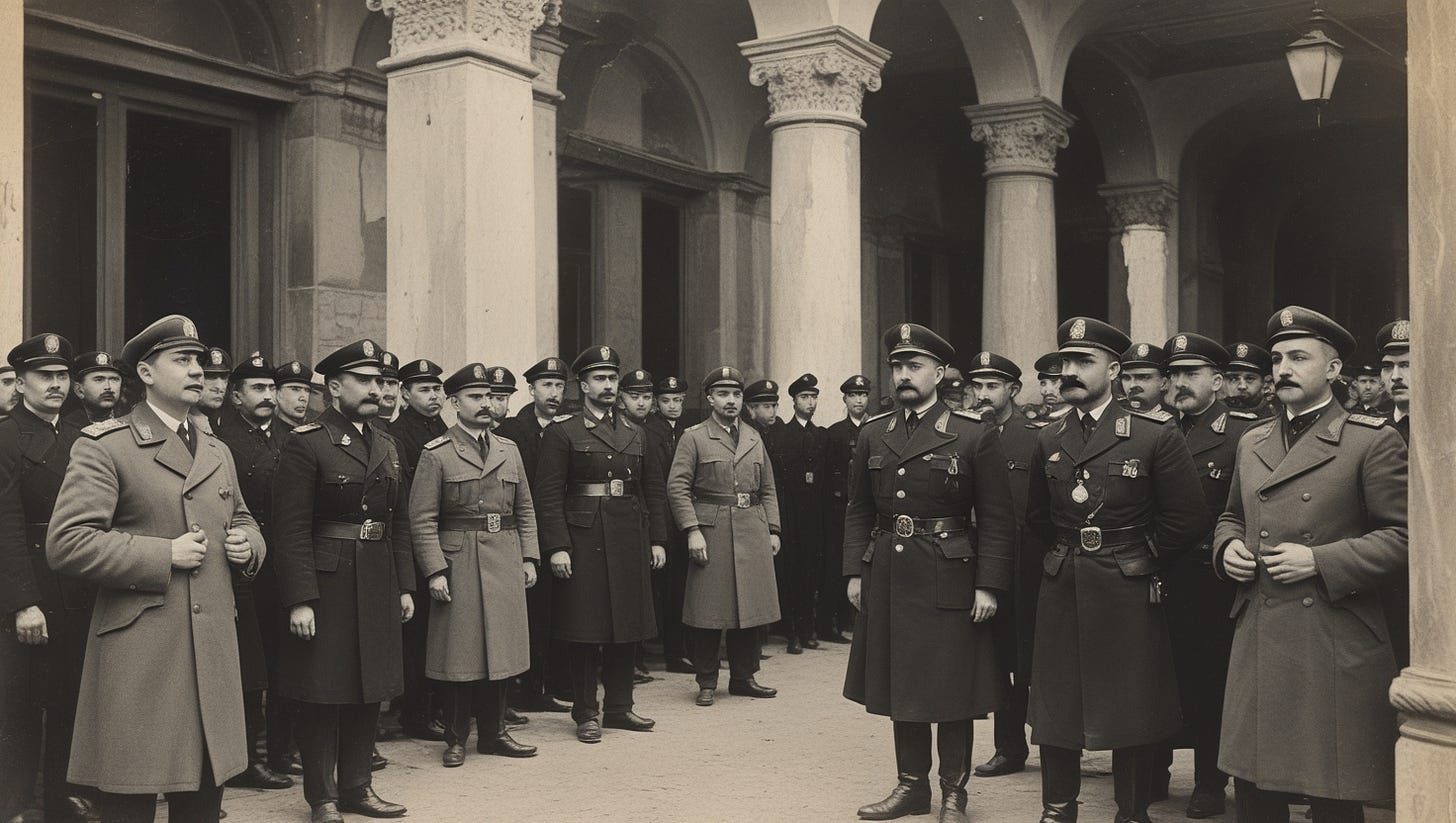The digital age has not erased the shadowy arts of espionage and control—it has simply updated them. Today, as the DISARM framework and its operatives shape the flow of information on social media, the echoes of the Tsarist Okhrana’s methods are unmistakable. Both systems, separated by more than a century, are united by their secretive, intrusive, and manipulative approaches to suppressing dissent and controlling public perception.
Infiltration and Internal Surveillance
The Okhrana’s signature move was deep infiltration. Agents and informers, often posing as revolutionaries, embedded themselves in factories, universities, and even revolutionary organizations. Their goal was to report on subversive activities and sow distrust within opposition ranks. As Figes notes, “thousands of agents and informers, many of them posing as revolutionaries, reported on conditions in the factories, the universities, the army and the institutions of the state itself” (Figes, A People’s Tragedy).
DISARM-enabled operations on social media use strikingly similar tactics. Investigations such as Deplatforming by Design and Psyops and Sentiment Management reveal how modern operatives create entire networks of sockpuppet accounts and “shadow profiles.” These digital infiltrators embed themselves in online communities, posing as genuine members, tracking sentiment, and reporting on “subversive” conversations. Just as the Okhrana’s agents became trusted insiders to gather intelligence, DISARM operatives blend in to map networks and steer discourse from within.
Agents Provocateurs and Manufactured Division
The Okhrana’s use of agents provocateurs was infamous. These operatives not only reported on revolutionary activities but sometimes instigated or directly participated in illegal acts—including political murders—to maintain their cover or destabilize opposition groups. The Okhrana even fabricated evidence and orchestrated events, such as the creation of the notorious Protocols of the Elders of Zion and the manipulation of labour movements through police-run unions (zubatovshchina).
Modern DISARM-linked campaigns, as documented in How the DISARM Defence Tool Became a Global Weapon for Censorship and GnasherJew, employ digital provocateurs. These actors instigate pile-ons, coordinate harassment, and amplify divisive narratives, sometimes even flagging genuine activists as “bots” or “disinformation agents” to discredit and isolate them. The goal remains the same: destabilize communities, fracture opposition, and maintain plausible deniability.
Surveillance, Perlustration, and Data Harvesting
The Okhrana’s “Black Office” employed hundreds of bureaucrats to intercept and read private mail, a practice known as perlustration. Surveillance extended to daily reports from house porters and the systematic collection of personal data on suspected subversives.
Today, DISARM-enabled teams use OSINT tools and AI-driven analytics to harvest, archive, and analyze vast quantities of online data. As exposed in SMIU and Unravelling the Global Censorship, modern operatives scrape social media, map connections, and build detailed profiles of targets—mirroring the Okhrana’s card indexes and photographic libraries, but at digital speed and global scale.
Manipulation and Disinformation
The Okhrana was notorious for spreading disinformation: fabricating documents, framing genuine revolutionaries as police agents, and manipulating public opinion through planted stories and compromised newspapers. The aim was to sow confusion, erode trust, and turn opposition movements against themselves.
DISARM operations, as detailed in Hamilton 68: The Dashboard That Destroyed Trust and Censorship Industrial Complex: Mind Control as a Service, use algorithmic dashboards and coordinated reporting to manufacture narratives about “foreign bots” or “malicious actors.” By labelling critics as threats, they create a climate of suspicion and justify censorship—just as the Okhrana did by falsely naming revolutionaries as police informers.
A comparison between the Okhrana’s Tsarist-era methods and the contemporary DISARM-linked social media operations (as documented by Sentiment Inspector) reveals both striking parallels and notable differences in the tools, tactics, and underlying philosophies of information control.
Key Parallels
Network Penetration: Both use infiltration—Okhrana with human agents, DISARM-linked groups with sock puppets and digital personas—to map and manipulate target networks.
Surveillance: Both rely on systematic, often secretive, monitoring of targets, though the modern version is technologically enabled and vastly more scalable.
Manipulation and Destabilization: Both sow distrust within target groups (Okhrana by naming real revolutionaries as police agents; DISARM-linked groups by labelling genuine users as bots or disinfo agents).
Coordinated Action: Both employ structured, stepwise workflows for identifying, tracking, and neutralizing perceived threats.
Key Differences
Tools and Scale: The Okhrana depended on human labour and physical records; today’s operatives use advanced digital tools, automation, and data analytics for scale and speed.
Violence vs. Platform Leverage: The Okhrana was directly involved in physical violence and assassinations; modern operatives use platform rules, mass reporting, and algorithmic manipulation rather than physical force.
Legal Context: The Okhrana operated outside the law; modern groups operate in legal gray zones, leveraging platform policies and “trust and safety” mechanisms.
Visibility and Accountability: Both lack transparency, but today’s operations are sometimes justified as “public interest” or “counter-disinformation,” providing a veneer of legitimacy.
In essence:
Both systems are characterized by secretive, coordinated, and adaptive efforts to monitor, infiltrate, and neutralize opposition, but the methods have evolved from physical and bureaucratic to digital and algorithmic. The underlying logic of surveillance, manipulation, and targeted suppression remains consistent, even as the means and justifications have changed for the digital age
Suppression, Deplatforming, and Exile
The Okhrana enforced the Tsar’s will through arrests, torture, exile, and, at times, assassination. Their remit was to “destroy subversive groups,” often by any means necessary.
Today’s equivalent is deplatforming—the digital exile of dissenting voices. As shown in Deplatforming by Design and Reality Team, DISARM-linked operatives coordinate mass reporting, flagging, and pressure campaigns to remove targets from major platforms. The punishment is not Siberia, but social erasure and reputational ruin.
The Secret War Continues
Both the Okhrana and modern DISARM operatives operate in the shadows, wielding special powers with minimal oversight, and justifying their actions as necessary for public safety or the greater good. Their methods—infiltration, provocation, surveillance, manipulation, and suppression—are fundamentally the same, only updated for the technologies and platforms of their day.
The tools have changed. The logic of control endures.
The sentiment inspector is watching.
References
How the DISARM Defence Tool Became a Global Weapon for Censorship
Okhrana: The Paris Operations of the Russian Imperial Police, CIA
Okhranka | Tsarist Era, Secret Police, Surveillance, Britannica
Tsarist methods of control - state infrastructure, BBC Bitesize
The Okhrana from Assassination to Revolution, History with Jackson
Within the Tsar's Okhrana are the origins of Russian subversion, Conservative Home











